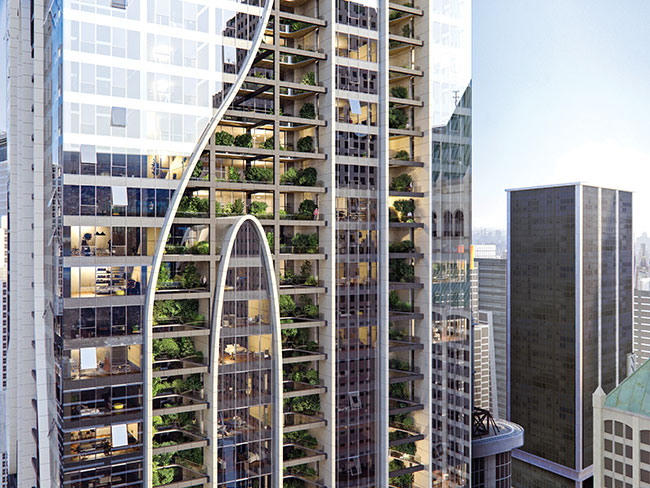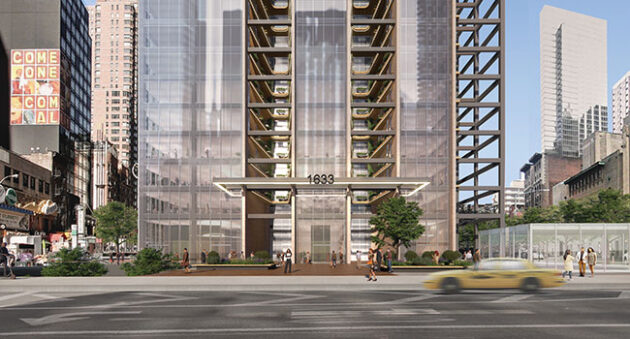
Features
Living where they worked
Converting commercial space to residential use carries some challenges for glaziers.
April 10, 2024 By Treena Hein
 Conceptual renderings for an SGA Architects project. Top concerns for facade designers converting commercial space include daylighting, ventilation and sound suppression. Also, supporting and draining the window assembly can be tricky if the conversion switches to a residential-style operable window.
Conceptual renderings for an SGA Architects project. Top concerns for facade designers converting commercial space include daylighting, ventilation and sound suppression. Also, supporting and draining the window assembly can be tricky if the conversion switches to a residential-style operable window. The huge increase in working from home during the pandemic changed many things in our society, including the use of downtown office space. So many firms have permanently adapted to having completely remote or part-time remote working scenarios.Company leaders also like the savings from renting less office space and, unfortunately, the pandemic also caused many other companies to go under, vacating yet more office space. Combine that with the dire need for more housing in Canada, and you have growing numbers of conversions of commercial buildings to living space. All over the country, office towers, but also malls and even industrial spaces, are being turned into condos and rental apartments.
Before we look at how the glass elements are handled within these conversions, here’s a quick overview of the trend and some of the government actions that are likely to accelerate it.
Leading cities
Rich Porayko, commercial business development director for Fenestration Canada, says he’s hearing about a large amount of discussion on this topic. As far back as 2005, he worked with Garibaldi Glass, who supplied the IG units for the condo retrofit of Westcoast Transmission commercial building in Vancouver, a notable project at the time and still today.
But in the market of Vancouver and its surrounding communities, Porayko reports that the trend of commercial-to-condo retrofits hasn’t caught on yet, “even though the rent and real estate prices are among the highest in the country.” In his view, paperwork and approvals are a big factor. He notes that while obtaining permits in Canadian cities is “daunting” for big projects like these retrofits, it’s especially tough to get it done in Vancouver.
However, as Geoff Shellard (architectural design manager at Guardian Industries in Vancouver) recently pointed out on LinkedIn, not many of the commercial buildings in Vancouver are viable for conversion anyway. There just aren’t many buildings that fit the criteria, he says, of older age and of limited present-day value, with a high level of vacancy, an appropriate location, manageable projected retrofit costs and a suitable building design.
While Vancouver may not have a lot of commercial-to-condo potential due to downtown building characteristics, another Canadian city has taken the undisputed national lead. It’s Calgary, home to more corporate head offices per capita than any other city nationwide.
By 2021, Calgary had experienced an extended downturn in oil prices and the COVID pandemic was in full swing. City leadership started up a unique incentive program, reports Porayko, one that’s unprecedented not only in Canada but across North America. The city reached its current funding limit of $253 million in October 2023.
“This program offered building owners $75 per square foot to convert underused office space into residential apartments,” Porayko reports. “Within a span of two years, the program has yielded approval for 13 office-to-residential conversion projects, while an additional four projects are currently undergoing review.” One example is the Dominion Centre, which will soon finish conversion to 132 new homes. The largest Calgary office conversion project to date, Palliser One, will be converted to almost 400 residences.
Incentives clearly work where the buildings are suitable, and could work to spur conversions in Vancouver, Toronto, Ottawa, Edmonton and Montreal, where downtown vacancy rates currently range from about 12 per cent to over 20 per cent. In London, Ont., it’s 28 per cent. In late January 2024, the city received $74 million from the federal housing accelerator fund, and staff are now preparing a proposal for a commercial-to-condo program.
In the U.S., Duanne Render at global design firm Render recently reported that Chicago is currently offering municipal, state and federal funding under a new commercial-to-condo initiative called “LaSalle Street Reimagined.” The city of Portland is also looking at offering a broad incentive package.
In October 2023, the U.S. Federal government published a guidebook for conversions, outlining funding opportunities, some of the regulations and so on. But across the U.S. – with and without incentives – many conversions have already been completed in numerous other cities like San Francisco, Atlanta, Boston, New York and Houston.

Design implications
On the building design front, floor plate size (the window-to-core distance inside a building) is a significant factor in terms of daylighting the condos that result from these building conversions. Deep floor plates make it harder for natural light to reach the interior of the apartment, especially if many walls are added. SGA, an architecture and interior design firm based in Boston and New York, has weighed in recently on floor plates and condo conversions on their website, noting that the sizes and dimensions found in office buildings often don’t “align nicely with ideal floor plate sizes and dimensions for residential units.” In these cases, to maximize use of natural light, SGA suggests the use of a light well, and/or open condo layouts that could include flexible indoor-outdoor spaces or balconies.
Many regulatory issues come into play besides typical building standards, from energy efficiency standards to affordable housing to asbestos abatement. Regulations in some jurisdictions need to be vastly updated as well, to address the specifics of these conversions.
Like any other construction project, the electrical, HVAC, glazing and all other aspects of a condo conversion require some proven solutions along with a little or a lot of unique approach.
But as Mike Battistel (president of Cascadia Windows and Doors in Langley, B.C.) explains, the changes that might be required to the glazing and glazed entrances of commercial buildings to make them suitable for residential living “really depends on what is there in the first place. In many cases, no changes would be required.”
He adds however, that “in some cases, if the windows are approaching the end of their useful life, it serves as an ideal time for window replacement when there will be no disruption to the occupants.”
That being said, office building facades aren’t always appropriate for residential use. “For example, when new partition walls need to be installed perpendicular to the existing fenestration system, the window frames may not be wide enough to accommodate the partition wall butting up to it,” Battistel explains. “In other cases, the window frames may not be positioned in the best possible location for the partition wall placement.”
Some experts point out that in some jurisdictions, such as California, compliance with the light and ventilation regulations for residential buildings requires the entire curtainwall be replaced with a system that incorporates operable windows. But new solutions have emerged. Battistel explains that it’s possible to install operable vent adapters into existing curtainwall glazing systems and some existing window wall systems. Cascadia Windows has a fiberglass curtainwall vent adapter specifically for this purpose.
Office buildings typically do not have as many operable vents as residential buildings, but Battistel adds that it’s possible to work around the dearth of windows with the ventilation system and also the fire suppression system.
George Torok, building science specialist with Morrison Hershfield, notes that some older office buildings considered for conversion have simple wall assemblies. “Precast concrete panel-clad walls are essentially face-sealed except for joints in buildings constructed since the late 1980s, which are likely to be two-stage or ‘rain screen’ type,” he explains. “It’s generally accepted today that windows should be installed with the window-to-wall joint following the rain screen principle. This may be difficult with residential window assemblies which generally have deeper frames than commercial window assemblies, which could be greater than the depth of the precast.”
Torok notes that if the new window assemblies are supported by the precast, some kind of sleeve may need to be added around the perimeter of the window openings to support the frame and allow for application of a waterproofing membrane for sub-sill drainage. Otherwise, a wind-bearing steel stud wall assembly will be needed inward of the precast to which a sleeve and waterproofing membrane can be applied, similar to the approach for new high-rise residential wall assemblies.
Mass-wall masonry assemblies would pose a similar challenge, he adds. “The detailing must also allow for connection to air and vapour barriers in the surrounding wall assembly, and the window should be positioned within the plane of the insulation in the wall assembly. At the exterior, new exterior frame-to-cladding sealants will likely be applied to existing, soiled cladding, which may affect adhesion.” A careful study of installation detailing should be made early in the design process to ensure such issues are addressed properly.
Looking at a specific conversion, the 360 Laurier project in Ottawa, Torok and his colleagues have reviewed the architectural drawings and he notes the plan is to replace the existing aluminum-framed windows with hybrid-framed products (usually vinyl interior and aluminum exterior). Torok thinks this is a good idea. “Canadian building codes have included an exception to using combustible-framed windows in high-rise buildings that typically must be built with non-combustible construction, provided that the window-to-wall ratio was fairly low and the window openings were separated from each other vertically and horizontally by non-combustible cladding,” he says. “That may be one of the design considerations for using hybrid windows in the 360 Laurier project. The 2020 National Building Code of Canada has removed those constraints – mostly – which may help with office-to-residential conversions, allowing high-performance windows to be installed on more extensively glazed buildings.”
Noise is also a concern in commercial-to-residential conversions. The team at Giroux Glass (an employee-owned glass, glazing and architectural metal firm in the U.S. southwest) recently pointed out in a blog post that because viable conversion candidates are often located in busy downtowns areas with high decibel levels, “replacing windows to ensure functionality also provides developers the perfect opportunity to improve their soundproofing as well.”
Torok notes that operable windows with low air-leakage resistance – especially hinged types such as awnings, hoppers and casements – will help with mitigating mid-to-high frequency sounds. He adds, however, that the glass package may need to be adjusted, too. “It’s already common for thermally broken aluminum-framed windows and window wall assemblies to include IGU with wide cavities between the panes to control noise,” he explains. “That’s the low-hanging fruit. It may also be necessary to consider using asymmetric IGU with two panes of glass of different thickness, in some cases with the inboard pane of laminated glass.”
This is not without challenges, and Torok notes that the frame must have flexibility to use IGU other than the usual symmetrical type with two panes of four-millimeter glass (typical for aluminum/vinyl hybrids) or six-millimeter glass with a 13-millimeter cavity. Also, the frame needs to be able to support the added weight of an asymmetric IGU, and the load needs to be transferred to the surrounding wall assembly through the installation detailing so the frame does not distort over time.
Overall, Battistel believes that if a building conversion “is done strategically and effectively, occupant comfort can be the same in most building types.” •
Print this page